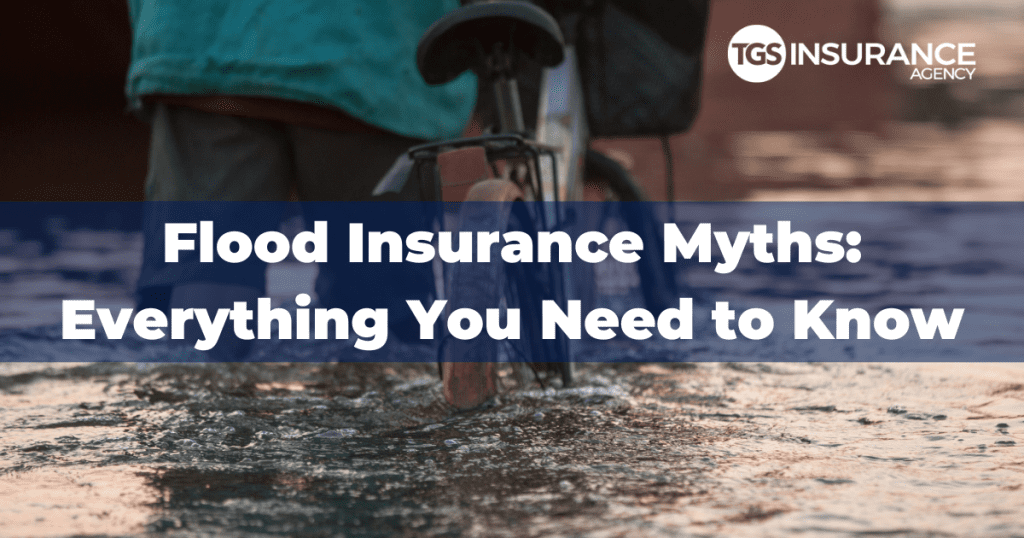
Flood insurance is often something people don’t think they need because they don’t live in a flood zone or an area prone to hurricanes, but it’s important to remember that no home is safe from flooding- regardless of where you live. There are so many myths about flood insurance, so take a look below at the facts so you can be better informed about what’s true and what’s not.
Myth #1: Flood Insurance is Included in Your Home Insurance Policy
A typical homeowners insurance policy might cover minor water damages but does not normally cover flood damages. You’ll want to purchase a separate flood insurance policy to get full protection from flooding.
Myth #2: “I only need flood insurance if I live in a high-risk flooding area.”
Every property is at risk for flooding, regardless of the area. FEMA stated. “It’s five times more likely to flood than to experience a fire in a 30-year period. More than 20 percent of flood insurance claims are from properties that are not in high-risk flood zones.” So if you live in a city that can flood, purchasing flood insurance’s not a terrible idea.
On the flip side, if you live in a neighborhood that is part of the National Flood Insurance Program (NFIP), purchasing a flood insurance policy is highly recommended.
Myth #3: Only Homeowners Can Purchase Flood Insurance
Flood insurance isn’t just for homeowners in single-family homes. It’s accessible for renters and commercial property owners too. Anyone wanting to protect their personal belongings and business is eligible for flood protection.
Myth #4: “I should wait until storm season to purchase flood insurance.”
Some individuals don’t always consider purchasing flood insurance until storm season is in full effect or until after a flood occurs in their homes. It’s important to take action when buying flood insurance because most policies have a 30-day waiting period before a flood insurance policy is active. Think about purchasing a flood insurance policy during a dryer part of the year, so you will be prepared when the harsh rainy season approaches.
Myth #5: Minor Flooding Won’t Be Too Damaging
Some might not realize that even minor flooding can cause consequential damages. According to FloodSmart.gov, an inch of water damage in a home can cost up to about $25,000 in damage, and the typical insurance claim for individuals who have flood insurance is about $30,000.
Myth #6: Flood Insurance Covers All of the Damages
Like typical insurance policies, flood insurance does have limits. According to FEMA, the common flood insurance policy covers about $250,000 in-home repairs and about $100,000 for personal belongings.
Commercial property owners usually receive a higher purchasing coverage plan and typically collect up to $500,000.
Myth #7: Government Assistance Will Cover the Repairs if My House Floods
In unique circumstances, “federal disaster funds” are offered to individuals who were victims of flooding. FEMA explains that “federal disaster relief funds are only offered if the president declares a disaster.” They also stated that “less than half of floods are declared federal disasters.” When a natural catastrophic event occurs, the usual federal disaster contribution is about $5,000 and is typically a low-interest loan that must be paid back. That is why it is highly recommended to invest in flood insurance because you are usually provided with more coverage, and the money provided for policyholders does not need to be paid back.
Myth #8: Flood Maps Never Change
A flood map displays an area’s chance of flooding. Most people don’t realize that a home or property’s chance of flooding can shift over time. As a community grows, the flood map changes to accommodate new construction and fewer green areas, resulting in less space for drainage. Other weather conditions and wildfires can also contribute to flood map changes, so staying up-to-date with any flood map changes is always a good idea.
Myth #9: Flooding Only Happens Once a Century in a 100-Year Flood Plain
This term doesn’t mean a flood will happen once every century. It means it has a 1 in 100 chance of flooding any year, according to FEMA. So say your property is in a 100-year flood plain that flooded last year. It could still flood this year.
It’s crucial to be aware and prepared for a possible flood. The more you understand what is covered in your homeowners insurance and flood insurance policies, the better off you’ll be.
Source: Allstate
Instant Home Insurance Quote
Recent Home Insurance Articles:
- Does Home Insurance Cover Vacation Rentals? Here’s What You Need to Know
- Home Insurance Coverage Gaps You Might Not Know Exist—Until It’s Too Late
- Grilling Safety Tips for a Secure Memorial Day BBQ
- How to Change Home Insurance with Escrow: A Step-by-Step Guide
- Pool Safety Tips for Homeowners: Stay Cool and Covered This Summer